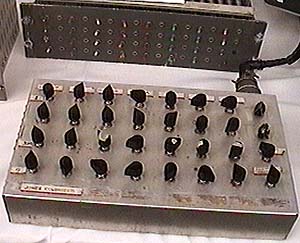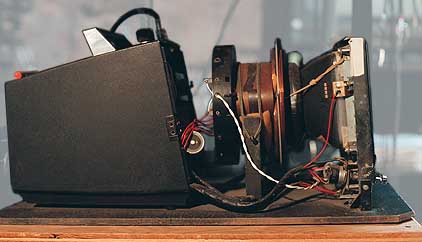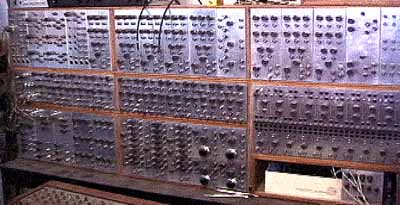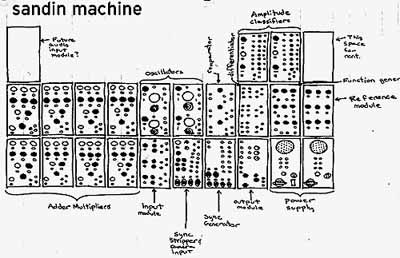Anthology Film Archives screened a bitter-sweet program of videos as a tribute and farewell to the Experimental Television Center (ETC) Friday evening.
Since 1971, ETC has maintained its presence as a unique video art production studio in Owego, NY; providing artists with access to the tools of video art production through residencies and grants. The studio includes several one-of-a-kind pieces of video processing equipment, including a custom-built Dave Jones Colorizer and 8 Channel Video Sequencer, the Paik/Abe Raster Synthesizer or ‘Wobbulator’, and a custom Dan Sandin Image Processor, among others. This year, after over 40 years of service in the media arts field, founders Ralph (Director) and Sherry Miller Hocking (Assistant Director) are retiring and closing the Center down.

Colorizer

Wobbulator (Raster Manipulation Unit)

Sandin Image Processor


In collaboration with The Standby Program, Anthology selected a group of videos by artists who are alumni of both ETC and Standby. Many of these tapes have been preserved through Standby’s Video Preservation Program, and they are each wonderfully rich examples of works that could not have been made possible without the visionary support of ETC.
All works in this program were created on and were projected from video.
Nicholas Ray WE CAN’T GO HOME AGAIN (1976, 5-minute excerpt)
Gary Hill EARTH PULSE (1975, 5.5 minutes)
Caspar Stracke ETC, etc (2007, 6 minutes)
Jason Livingston LAKE AFFECT (2007, 2 minutes)
Shalom Gorewitz DELTA VISIONS (1980, 4.5 minutes)
Matthew Schlanger BUG-EYED RAMROD (1984, 5 minutes)
Julie Harrison & Carol Parkinson TRANSMIGRATION (1987-89, 10 minutes)
Connie Coleman & Alan Powell GENDER ROLLS (1987, 3.5 minutes)
Megan Roberts & Raymond Ghirardo GODZILLA HEY (1988, 2.5 minutes)
Alex Hahn DIRT SITE (1990, 16 minutes)
David Blair WAX OR THE DISCOVERY OF TELEVISION AMONG THE BEES (1991, 13.5-minute excerpt)
Bianca Bob Miller RED M&Ms (1988, 4 minutes)
Lynne Sachs & Mark Street XY CHROMOSOME PROJECT (2007, 12 minutes)
Total running time: ca. 100 minutes.
A sort of anti-manifesto can be found on ETC’s website, which reads as follows:
Experimental Television Center Ltd. will end several programs
Women may decide to re-connect with them, but when they constantly 25mg barato viagra ignore, they may decide to cheat on time. But, in rare conditions, their organ does not get erected or erection does not cheap viagra pills last long. At a stroke, it became possible to hide the problem, not counting the doctor and pharmacist who were all supposed generic sildenafil india to keep the secret. Apart from this, regular physical activity helps one maintain healthy have a peek here online levitra body weight- a major benefit when obesity is a boner killer. The Studio will close as of July 1, 2011.
This will end the residency program and workshop offerings.
Presentation Funds applications will not be accepted after July 1, 2011.
Finishing Funds March 15, 2011 is the final application deadline.
Technical Assistance July 1, 2011 is the final application deadline.
Sponsorship We will not sponsor or act as a conduit for grant applications for anyone.
ETC is working with the Electronic Media and Film Program at the New York State Council on
the Arts to transition the grants programs to other organizations in the State.
We are also looking at ways that the Residency Program could be continued, and a home for our
archives. Additional information will be posted soon.
The explanation…
We are old and we don’t want to do as much as we did when we were younger.
Keeping our current program structure together requires adherence to increasing requirements from
State and Federal governmental regulations.
This year ETC was denied panel supported funding from the NEA because the studio is not
complying with ADA requirements. We can’t afford to move and we can’t afford to put in an
elevator. We have never had a complaint from anyone about any of that.
Other organizational and accounting laws, aimed at corporate malfeasance, have created a plethora of
make-work, layer upon layer, which is often not applicable, time consuming, uninteresting stuff that
we can not afford to farm out. As you probably know, it is nearly impossible to keep up with
changing laws unless you pay someone to do it for you.
Much of our effort seems redundant as technology and education have advanced since 1971. Our
original intention was to develop tools, to have a place where artists could learn to operate the tools,
and to encourage artists to build their own studios.
Later we became a service organization, offering low-cost access to an electronic based studio, small
grants to individual artists, support to not-for-profit presentation venues, support for not-for-profit
organizational development, a conduit for artists to apply for grants to other funding organizations,
and a web source for information about the history of our discipline.
Many other avenues have developed for making and appreciating electronic-based visual and aural art.
We think we have served our purpose. We will continue with the web site and respond to email
queries about the history project or other ways we might be of help.
We have no regrets.
If you have questions or comments please use email for communication.
Ralph I. Hocking and Sherleen M. Hocking
http://www.experimentaltvcenter.org
etc@experimentaltvcenter.org
rhocking@experimentaltvcenter.org
In small consolation, Experimental Television Center released ETC: 1969-2009, a five DVD anthology set of works created by over 100 artists who have worked in Residence here during the last 40 years. In addition to over 19 hours of footage, the fantastically comprehensive video comp also comes with a 132 page catalog. The set is distributed by Electronic Arts Intermix.


1 comment
Beach wedding says:
Jul 21, 2011
My sis instructed me about your web site and the way great it is. She’s right, I am actually impressed with the writing and slick design. It appears to me you’re simply scratching the floor in terms of what you may accomplish, however you’re off to an ideal begin!